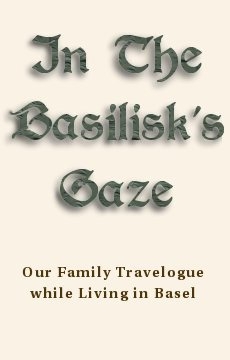The Three Most Beautiful Days of The Year
 Thursday, May 6, 2010 at 4:01PM
Thursday, May 6, 2010 at 4:01PM Every year Baslers put on one of the most astonishing festivals, the Fasnacht. It runs for three days in the week following Ash Wednesday (late February or early March), 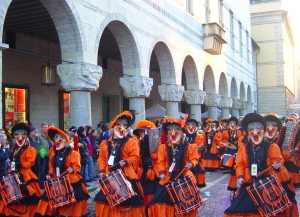 during which time the entire city shuts down to take part in the fun.
during which time the entire city shuts down to take part in the fun.
It all begins on Monday morning at 4am, when tens of thousands pack the narrow spaces of the city centre. The cliques (Fasnacht societies) assemble in costume with their enormous lanterns and musical ensembles. At the stroke of four, all the street lights turn off and the crowd is plunged into darkness. At that moment the cliques begin to play, filling the streets with sound, and the marching starts. This is the Morgenstraich (morning stroke).
In 2009, we stayed in our beds but were awoken by the sound, even though our apartment is half a kilometre from the city centre. This year, Rebecca and David were visiting us from London and Mark dragged himself out of bed to see it with them. 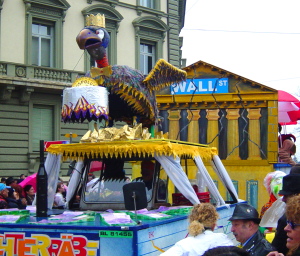 The atmosphere was electric — and it felt surreal to be surrounded by action on darkened city streets. The march continues until mid-morning before everyone goes home to catch a few hours’ sleep.
The atmosphere was electric — and it felt surreal to be surrounded by action on darkened city streets. The march continues until mid-morning before everyone goes home to catch a few hours’ sleep.
The action resumes in the early afternoon with the cortege, an enormous procession that runs in both directions on a circuit of the city. Well over 12,000 official marchers take part, being a combination of cliques, wagons, pipe and tambourine groups, smaller fancy dress groups and so-called Guggenmusiken (mobile pop bands). The cliques march in bizarre costumes and play traditional music, as well as pulling the lanterns and handing out sheets of topical Swiss-German poetry. The wagons, around 140 of them, are hauled by decorated tractors and contain characters called Waggis (singular) who wear masks with enormous hair-dos made from ribbons and who throw gifts and confetti over the crowd. And the Guggenmusiken generally just rock on.
When the cortege is operating, the route is constantly filled with marchers going in both directions, even though it is over three kilometres long.  Marching groups leave and enter the stream to break for food and drinks, but there are always enough to fill the route at any given time. A sense of the atmosphere is captured in this video. So much confetti is thrown that the streets are soon covered in a layer several inches deep. Some of the wagons even have special air cannons that blast confetti in a huge cloud five metres long.
Marching groups leave and enter the stream to break for food and drinks, but there are always enough to fill the route at any given time. A sense of the atmosphere is captured in this video. So much confetti is thrown that the streets are soon covered in a layer several inches deep. Some of the wagons even have special air cannons that blast confetti in a huge cloud five metres long.
Other groups of costumed pipe and drum players, or street performers, roam the streets, both in parallel with the cortege or during the breaks, and in the evenings, when there are also concerts, and the restaurants and bars are open to serve the crazy hoards. We went to one concert where the bands, Guggenmusiken, marched onto and off the stage on a ramp, while continuing to play, so the music never stopped.
On Tuesday it is children’s day, where smaller wagons appear manned by children. And on Wednesday it is back to the main cortege, with the lanterns on display outside the cathedral. 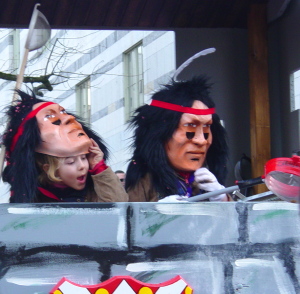 The celebrations continue like this until 4am on Thursday morning, when there is a final blast of drums, pipes and brass to mark the close.
The celebrations continue like this until 4am on Thursday morning, when there is a final blast of drums, pipes and brass to mark the close.
All of this is partly funded by the sale of special badges called Blaggedde, which are coloured bronze, silver or gold depending on how much you choose to donate. If you watch the cortege, it’s a good idea to buy one and wear it. Otherwise the Waggis might decide to pick on you.
In 2009, aunt Sabine and cousin Lea came down to stay for the festivities. The boys and Lea had great fun dressing in costumes, as shown below, and going out to the cortege. They ran after the wagons shouting “Waggis, Waggis” and were given gifts in return. Over the three days, they each collected around a kilogram of sweets of all kinds, and various fun objects such as toy cars and fridge magnets.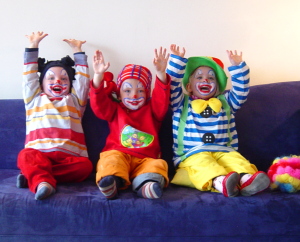
Because the wagons are so large, the children often need to be lifted up for them to collect the Waggis’ gifts. At one point Sabine was carrying Loxon on her shoulders for this purpose, and his leg covered her Blaggedde. As can be seen below, a Waggis decided she deserved the standard punishment for not wearing one; he grabbed her by the collar, and stuffed several handfuls of confetti down her back.
For weeks after Fasnacht, the children continued to play “Waggis, Waggis”, building makeshift wagons from dining chairs and sofas, pretending to shoot confetti from paper rolls and handing out gifts. It is an unforgettable experience, three days of utter frivolity, and well worth attending at least once in your life. The Baslers call it Die drey scheenschte Dääg (the three most beautiful days).

